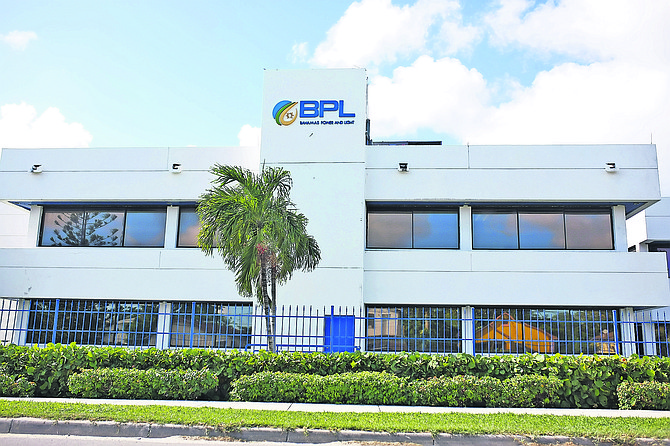• Even as fuel woes ‘substantially ate’ benefits
• Report reignites political row over hedging
• Minister: ‘Don’t try to bend on this hedge’
By NEIL HARTNELL
and FAY SIMMONS
Tribune Business Reporters
The Prime Minister was told Bahamas Power & Light’s (BPL) fuel hedge, which his administration has sought to discredit, was “in the money” even though fuel woes “substantially ate into the benefits”.
Shevonn Cambridge, BPL’s current chief executive, in a July 30, 2023, report to Philip Davis KC and Alfred Sears KC, then-minister of works and utilities, signalled the former Minnis administration’s fuel hedging strategy had generated savings for consumers that were sufficient to offset the utility’s greater-than-predicted use of higher cost fuel.
The report, which reviewed issues impacting operational performance at Clifton Pier’s ‘Station A’, said BPL’s hedged fuel price depended on the seven Wartsila engines that it housed “providing substantially more energy than they did” as well as using a fuel mix that was 60 percent weighted in favour of heavy fuel oil (HFO).
That is cheaper than automated diesel oil (ADO) which, according to Mr Cambridge was supposed to only meet 40 percent of the Wartsila engines’ needs under BPL’s fuel hedging strategy. However, that 60/40 mix intended to support the utility’s 10.5 cents per kilowatt hour (KWh) hedged price, which was locked in from summer 2020 to October 2022, was never achieved in any of those years.
“The units operated on 25 percent HFO and 75 percent ADO in calendar year 2020; 32 percent HFO and 68 percent ADO in calendar year 2021; and approximately 50 percent HFO and 50 percent ADO in calendar year 2022,” Mr Cambridge wrote to Mr Davis and Mr Sears.
However, according to BPL’s chief executive, who was not in the post when the fuel hedging strategy was executed, while the more expensive costs associated with this undesired fuel mix squeezed and slashed the anticipated savings for consumers it did not eliminate them entirely.
“Luckily, the fuel hedge placed at that time was in the money,” Mr Cambridge wrote. “However, the adverse generation fuel mix substantially ate into the benefits realised from the hedge.”
The phrase “in the money” triggered a heated back and forth during yesterday’s House of Assembly debate on the Speech from the Throne as it threatened to reignite the political controversy over BPL’s fuel hedging initiative.
The Opposition seized on it to repeat arguments that the strategy had initially produced significant savings for Bahamian businesses and households, but the Davis administration’s decision upon taking office not to acquire the extra cut-price fuel volumes needed to support the 10.5 cents per KWh price ultimately led to this summer’s sky-high light bills.
Michael Pintard, the Free National Movement’s (FNM) leader, argued that the initiative had already produced fuel cost savings of $25m for Bahamian consumers when the Minnis administration was voted out of office in September 2021.
He added that these savings could have increased to $55m by January 2022 if the strategy had been continued and supported. It was the Davis administration’s “bad decision” not to do so, Mr Pintard argued, that resulted in BPL’s fuel charges rising by 163 percent over an eight to ten-month period to hit 27.6 cents per KWh during this summer’s peak consumption.
“There is a report.. that clearly lays out the benefit of the hedging programme. What it showed is $25m was saved during the hedge programme and, at its conclusion [January 2022], $55m would be saved,” the FNM leader argued.
“As a result of the bad decision made, we now have an increase of 163 percent in the surcharge. As a result, electricity bills are doubling for many businesses, middle class Bahamians and vulnerable Bahamians.”
Jobeth Coleby-Davis, minister of transport and energy, highlighted the inefficiencies and extra costs imposed on BPL consumers by the sub-optimal fuel mix. She maintained that BPL’s current woes stem from previous “poor decisions”, and that the hedge would no longer be beneficial due to volatile oil prices and the more expensive fuel mix.
She said: “What I am trying to advise is that it’s a domino effect from the poor decisions that have been laid out in this report that we are now experiencing and suffering today. So no matter how much you try to bend on this hedge… let me tell you, you were not going to be in the money because of the volatile price of oil and your fuel mix. This is what the report from BPL is saying.”
The Davis administration has previously described the BPL fuel hedge initiated by its predecessor as not being worth the paper it was written on. It has also argued that it had to prioritise repayment of a $246m BPL loan that was falling due in early 2022, with no funds allocated for this purpose, and thus there was nothing available to finance further hedged fuel purchases.
With fuel hedging, utilities such as BPL typically do not lock-in a price that secures 100 percent of their needs. This is done to minimise risk, cost and exposure in case they find themselves on the wrong side of an unexpected oil price move. As an example, they may hedge 80 percent of their fuel needs for the first year, 50 percent in the second and 30 percent in the third.
The Davis administration elected not to execute the trades that would have secured the extra cut-price oil volumes necessary to cover 100 percent of BPL’s fuel needs. However, they also held BPL’s fuel charge at the original 10.5 cents per kWh for a further 12 months until October 2022 even though - without the extra hedged volumes - the actual fuel costs were considerably more.
This compounded the fall-out from the earlier decision not to support the original hedge. The Government effectively subsidised BPL to ensure the 10.5 cents price could be maintained, which is something that the regulations accompanying the Electricity Act prevent it from doing, as fuel costs are supposed to be 100 percent passed through to the consumer.
The Government’s need to recoup its $110m loan, and reclaim the under-recovered fuel costs, is what has caused the electricity monopoly’s fuel charges and overall bills to spike well in excess of market costs. This ultimately represents a major wealth transfer from Bahamian businesses and households to the oil companies.
Mr Cambridge’s report, meanwhile, said the Wartsila engines in ‘Station A’ had to use more ADO fuel than planned because the HFO’s quality was not up to standard. This, in turn, inflicted further problems and costs via “premature wear of the engines’ components” that doubled the amount of maintenance overhauls required, while cooling system woes caused “a notable drop in output” during the summer.
“Beyond the fuel use inefficiencies, in 2020, the records indicate that eight HFO booster pumps and two ADO pumps were replaced,” Mr Cambridge wrote. “This is an indication that the HFO being pumped was too thick or not properly heated, which adversely impacts the ability to pretreat, pump/transfer and properly burn it in the engines.
“This problem eventually manifested itself further with premature wear of the engines’ components, which resulted in the scheduled 24,000-hour overhauls having to be performed at the 12,000 hour interval. The overhaul for each unit was $957,000 or $6.7m compared to the estimated $334,000 per unit or $2.3m, triple the cost.
“Thirdly, in Wartsila’s annual performance report 2022, it revealed a notable drop in the output of the engines during the critical summer peak load season due to fouling of the bore hole cooling water system that resulted in lower MW (mega watt) outputs,” Mr Cambridge wrote.
“This could have been prevented by having a closed-loop radiator cooling system as suggested in the original design proposal. The closed system would have allowed for more effective cooling to prevent engine overheating and facilitate higher engine outputs.”
Based on an 80 percent “load factor”, and 80 percent availability, Mr Cambridge said the Wartsila’ engines total electricity generation output fell below expectations during the three-year period to end-2022. “Essentially, it can be surmised that these deficiencies resulted in less-than-optimal engine outputs from the entire Station A plant,” the BPL chief executive added.
“In its first year, the seven engines produced 560,500 MW hours. In 2021, 648,200 MW hours of electricity were produced and in 2022, 561,900 MW hours were produced. By industry standards, the seven engines should have been producing 740,000 MW hours annually.”







Comments
Use the comment form below to begin a discussion about this content.
Sign in to comment
OpenID